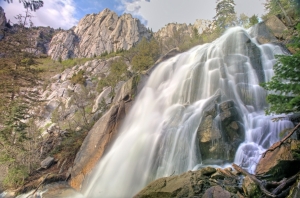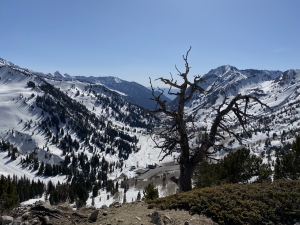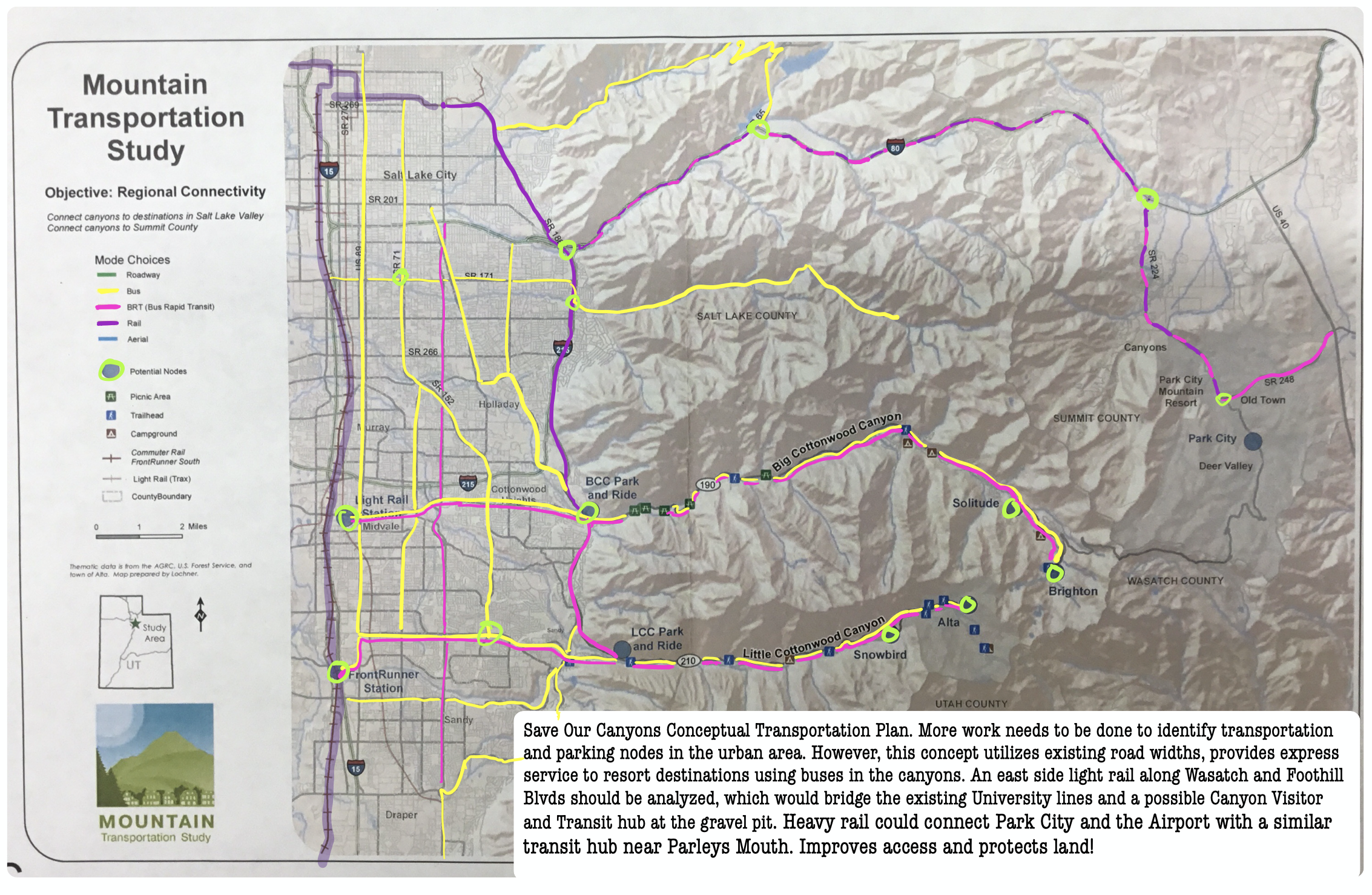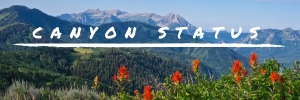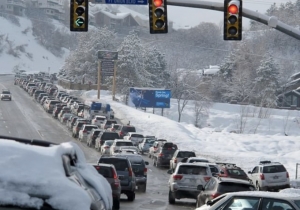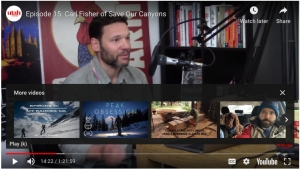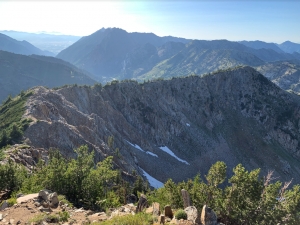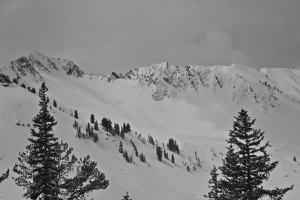Carl Fisher
Wasatch Resilience— Protecting Utah Lands Buffers Climate Change!
Motorized vehicles, phones, and computers are technological advances that we have invented to provide convivence and comfortability, enhancing our daily lives. While we use them intrinsically, human subsistence is captured in these five necessities: air, water, food, shelter, and clothing. Some of these necessities are more important to our survival over others, if one or more are removed from our daily lives we enter a standard of living that does not meet our needs. If this degraded standard is prolonged death is imminent. Climate change— a phenomenon that is putting strain and challenging our access to these necessities is occurring globally. Locally, to preserve a high standard of living and ward off the impacts of climate change we need to be protecting undeveloped lands in Utah and identifying local human pressures perpetuating climate issues, in turn, safeguarding our necessities.
In August 2019, the Intergovernmental Panel on Climate Change released a report called “Climate Change and Land.” As reported by the Desert News, we need to take action protecting local land as it bolsters resiliency and buffers us from the impacts of a changing climate. Utahns need to support and pass legislation that zones off and offers further protections to intact landscapes. Locally, in Salt Lake County, there is growing support for legislation (Central Wasatch National Conservation and Recreation Area) that would protect 80,000 of public land in the Central Wasatch mountains from further fragmentation. Within the land proposed for designation there are watershed areas. Protecting watershed areas leaves waterways uncontaminated from chemicals and debris making great drinking water for Utah's growing population. Watershed areas also help fight desertification, preventing erosion which makes the land less fertile.
Furthermore, identifying current and future vulnerabilities that exacerbate climate-related impacts and then implementing more sustainably efficient policies will help our environment respond to a changing climate. An article released by Reuter’s summarizes the results of a think tank conducted by the Center for American Progress, titled, “How Much Nature Should America Keep?” The article discloses that in America a football field worth of natural land is lost every 30 seconds, and over a 16-year time-period 24 million acres of natural land has been lost. Development in America is occurring at rapid rates that do not allow the environment and landscapes being affected to adjust to the new conditions, hindering their ability to recover and protect us and itself from catastrophic events. Locally, failure to put in place policies that prioritize watershed health, resilient forests and protect wildlife habitat could result in catastrophic wildfires, flooding, loss of species and degraded water quality.
Coincidently, setting a goal of permanently protecting at least 50% of Utah’s land will ensure we will be prepared to deal with the impacts of climate while working to realize other critical actions to sustain life as we know. Referring back to the IPPC report, one of the main takeaways was establishing better and more comprehensive forestry management practices. Utahns need to protect forest lands which make up roughly one-third of the state. We can start this conservation effort locally by protecting forestland in the Central Wasatch. In a conservative estimate, 30% percent of forestland in the Central Wasatch has been lost to development. This does not include the possible loss of land associated with road fragmentation, and pollution from transportation and development.
Collectively, trees and other plants within forestland act as a carbon sink; a natural buffer that sequesters the atmospheric greenhouse gas carbon dioxide; which is a huge contributor to climate change. Plants absorb carbon dioxide naturally through photosynthesis:
CO2 (carbon dioxide) + H2O (water) + photons (light energy) → [CH2O] (carbohydrate) + O2 (oxygen)
This process may look daunting, but can easily be understood using the analogy of baking a cake. The raw ingredients or inputs of photosynthesis are carbon dioxide and water. Once the ingredients are mixed together and put in the oven or exposed to sunlight, eventually a cake will be produced or in this case carbohydrates and oxygen. The oxygen is released into the environment, however, similarly how we consume cake we just made, plants consume the carbohydrates (transformed carbon dioxide) and the carbohydrates will be stored within the trees for the remainder of their lifetime.
Forests play an important role in preventing, buffering, and restoring the impacts of climate change. The Uinta-Wasatch-Cache National Forest, containing over a net acreage of 2,169,596 acres of forested land, may be aging but is still no exception. Right now, only seven wilderness areas have been established. These wilderness areas only make up 25% of the forest’s acreage. We need to strive to increase protections in this forestland range! While some people do not support protecting public land containing forests locally and nationally due to their worry of poor forest management creating hazardous wildfire conditions. I see this as a huge mistake and a superficial excuse because upon further investigation statistics from Utah Fire Data shows that in 2017 92% of wildfires were started in developed areas and were caused by humans.
In this post, I have discussed many issues and opportunities the Wasatch is currently facing. How much more of the Wasatch are you willing to sacrifice? How long will it be before it’s too late to protect pristine Wasatch land? Let’s take action today! For a hospitable future, prosperous society, and a cleaner Utah it is imperative that we start taking action in protecting Utah land— public land— land in the Central Wasatch. These are critical areas that are fragile to development, yet while intact they play major roles in the defense against climate change.
You can support the protection of Utah land by engaging with your Congressional representatives and legislatures by writing or calling them. Save Our Canyons also has many opportunities for you to voice your support and steward the protection of the Central Wasatch. You can become a member or donate, support the NCRA via attending the Central Wasatch Commission meetings every 3rd Wednesday of the month at Cottonwood Heights City Hall and sign our petition, or even getting out in the wilderness and volunteer at one of our Wilderness Stewardship Projects or contact our Education and Stewardship Coordinator Luke Golden at ). Thanks for your support, LET’S SAVE OUR CANYONS!
Watch the Save Our Canyons Transportation Presentation Zoom Hangout Video
View the ![]() Power Point Presentation from Zoom Hangout; July 7th, 2020
Power Point Presentation from Zoom Hangout; July 7th, 2020
Submit Comment: UDOT Little Cottonwood Canyon EIS Public Comment Form
As resorts come up with new ways to market themselves, we are being asked to sacrifice the environment and foot the bill to ensure their continued success. This is by its very definition, unsustainable. How much more taxpayer money will be spent to support resorts and destroy our canyons? The natural constraints of mountains are what make them, well, mountains.
It’s no secret that we’ve been skeptical that UDOT's Little Cottonwood EIS could yield positive outcomes for our intensely loved and incredibly important Wasatch Canyons. As the process has worn on, which the former project manager urged us to “trust”, no only has our trust been continuously betrayed, but it is clear that there are a few things UDOT has concerned itself with, and none of their concerns stand to benefit the region, our communities, the users and certainly not the environment. We now know why the State has fought protection of the Wasatch - it wants to build a massive interconnect - it is plain as day in this EIS. If we can’t agree what the problem is, there’s really no hope in finding a solution, and UDOT has not only rejected input from SOC and our partners, but also rejected input and concerns from watershed managers too.
Unsurprisingly, the State’s priorities are money, tourism, resorts and their road. The “Draft Alternatives Development and Screening Report” was released on June 8th, 2020 and public comment will be open until July 10, 2020. Our goal here is to help you understand the process and the alternatives, and aid you in submitting comments in hopes you can influence the process. Of course, Save Our Canyons, as we do, attempts to draft our own comments that reflect the sentiments of our members. As you can appreciate, a loyal Alta or Snowbird skier who’s relationship with the Wasatch is defined by that activity, could have a very different opinion on what the solution is than a mountain biker, climber, hiker, backcountry skier, hunter or someone whose relationship is drinking water that comes from the canyon.
Before I jump into the Alternatives, let's understand what initiated the EIS. In 2017, the Utah Legislature passed a bill SB 277 - Highway General Obligations Bonds Authorization, which contained a section on what was later referred to as “Recreation Hot Spots”.
The strings attached to this funding said:
(i) have a significant economic development impact associated with recreation and tourism within the state; and
(ii) address significant needs for congestion mitigation.
This passage of this bill triggered a convening of the UDOT Transportation Commission, who ultimately decided $66 million of the $100 million authorized would go to Little Cottonwood Canyon.
Then, in 2019, the Legislature passed SB 268 - Transportation Infrastructure Bond Amendments, which included this provision:
(xvii) $13,000,000 for corridor preservation and land acquisition for a transit hub at the mouth of Big Cottonwood Canyon;
These few provisions set the stage for the process we are now in. It is also worth noting that when the Little Cottonwood EIS (LCC EIS) first started up, there was also a promise of simultaneously doing a more holistic approach called the Cottonwood Canyons Transportation Action Plan (CCTAP), which was to be done in partnership with the Central Wasatch Commission. In 2019, UDOT reneged on its promise to be comprehensive and collaborative, killed CCTAP and abruptly resigned from the Central Wasatch Commission. The Central Wasatch Commission’s stakeholders were certainly dubious of UDOT’s intent and appeared to be winning favor amongst commissioners who were beginning to ask questions, ultimately leading to UDOTs resignation. The beef: UDOT wasn’t interested in looking at canyon capacities and how the impact of intensifying economic development activities and increasing tourism (as directed by SB 277) would manifest itself in the region, not to mention the impact on our watershed canyons, wildlife populations, and local communities.
Our fears have come to fruition and are documented in the most recent report. UDOT has only concerned itself with their road and the resorts, doubling down on three of Utah’s loves: roads, cars and exploitation and industrialization of our natural wonders. History has demonstrated that we are better at building ourselves into new problems than out of the ones that already exist. All this when overwhelming public sentiments are calling for transit-based solutions and protection of the Wasatch - which really shouldn’t be a hard ask.
With that prelude, let’s get to the so-called alternatives, the solution to the problem no one can agree on. As UDOT has laid it out, there are three options: one is the world's longest and most inefficient gondola, the other two are “enhanced buses”, which could have been good, but the bus is simply an appetizer to a gorging entree of infrastructure projects - more lanes and avalanche sheds. All the alternatives are intensively reliant upon cars, to and within the canyon, which is why a transit agency, rather than a road building agency should be the lead in transit service design.
Gondola
No one is really shocked that after 40-some years of advocating for ski interconnect that the state included a gondola as an alternative. Nevertheless, it is still always jarring to see it documented. The most significant issue with the gondola is, and will continue to be, parking: there is no space to accommodate at least 10,000 vehicles anywhere in the vicinity of the canyons. And since the state throws most of our money at failed road projects, there is no money for transit, so getting to the mouths of the canyons without a car is neither a priority or a possibility.
Most transit planners cringe at having one transfer, but it is more often than not a necessary evil. Two transfers are even less desirable, and three is basically considered a fatal flaw and ineffective transit. Think about it, how many times do you want to move your or your kids’ skis from one mode to another?
The gondola mobility hub (which SB 268 funded), will have about 2,500 spaces for cars. Being that it is located at the mouth of Big Cottonwood, one would assume that some of those stalls would be occupied by folks seeking to carpool or take transit up Big Cottonwood... or will this be exclusive to those going up Little? If you live in Granite, Sandy or Draper, you’ll have to drive past Little Cottonwood to Big, where you’ll enjoy the traffic you are trying to escape before getting on a bus heading back toward whence you came, to then catch the gondola.
If you are visiting the Wasatch for another purpose other than patronizing a resort, you are S.O.L. UDOT’s own traffic data shows the peak that is causing the problems is happening in a 3 hour window. The gondola will only transport about 900 people every hour with about 21,000 people trying to get up the canyon. So about 3,000 people will get up by gondola in this window, and 18,000 will still need to use cars on the road. They claim a reduction of about 350 vehicles per hour, and cite that canyon road closures (which again, 18,000 people will need to rely on) in the gondola scenario will double at best, from today’s 10.4 days (56.3 hours) to 21+ days (108+ hours). This works well for the lucky 3,000, the rest of us will be stuck in the same (or worse) traffic, forced to look at the gondola that ruined the canyon, that you can’t get on because there is no parking, no transit or the road isn’t even open.
Finally, this is not found anywhere in the EIS, rather it was mentioned in a meeting we and other organizations had with UDOT. One “benefit”, they say of the gondola is that they can induce tourism demand in the summer by selling tickets to ride the gondola as if it were a ride at Lagoon. These canyons are enough of an attraction themselves, they don’t need more crap built, exploiting the natural scenery.
As one of our resident transportation experts put it, gondolas are great for places where you can’t build roads, like up a steep mountain. But the road is always going to be more effective and expeditious at transporting people. Little Cottonwood has a road. If we wanted to have the conversation about transporting people without it, let's do it, but that isn’t at all the question or an option UDOT is willing to consider. The gondola fails the canyon, the users, and the resorts.
Avalanche Sheds, Road widening & Berms
These elements accompany the enhanced bus options. It is important to note that UDOT has decided the problems in the Wasatch are not year-round, they really are only 4 or so months of the year, despite year-round intensification of recreational activities, not to mention the year-round impact of climate change causing uncertainty for our water supply, quality not to mention the viability of the ski industry. We currently have about 10.4 days (56.3 hours) that the canyons are closed. The best alternative reduces canyon closures by 4 days (11 hours). So look at these impacts that will fundamentally alter the wildness and beauty of our canyons… for a 4 day (40 hours) benefit for resort skiers.
One scenario has a longer avalanche shed, the other a shorter shed, but with berms and a widened road. All of these proposals will cause impacts to the hydrology and erosive activities in the Wasatch.
Mobility Hubs
Above, I talked a little about the gondola mobility hub. Again, these hubs aren’t inexpensive, they will have traffic impacts, albeit in different locations, but will absolutely cause congestion at peak times. Further, because this is a project that only looks at Little Cottonwood Canyon roadway (UDOT rejected numerous requests to be more comprehensive), the analysis has failed to contemplate usage for Big Cottonwood. Let’s face it, there is a lot of parking lots out there but they aren’t all able to be used to coordinate carpools and transit. It might not be possible to get everyone to the canyons by transit, but we can certainly make a few hubs throughout the valley to aid in getting people to hubs within say, 5 miles from home.
Enhanced Buses
We like the idea of the buses. As mentioned, we take issue with the other elements they’ve attached to the bus. If we can get more people on transit and increase vehicular occupancy (from 1.8 to say 4) there will be less cars in the canyon. Less cars means less need for parking and less need for a lane. Less cars also means less lining up at the mouth. So forward the buses, but without the sheds and the lanes and make these buses penetrate further into our communities in the valley giving more people, better access. You could even run articulated buses from the communities to the mouth (though that would indeed force a transfer). Express buses where Alta patrons don’t have to ride through Snowbird, for example, is a great idea and should be pursued. It should be noted that you shouldn’t need an EIS to just run more buses on the roadway. So you can like buses, and hate this EIS! Fund UTA, not UDOT.
New Parking Lots
This is pretty much the only thing that could benefit the average user of the Wasatch. Of course, parking lots are not environmentally friendly at all. A better option would be to have transit serve some locations. We’d need to figure out, where, how many people, and how it would be managed, but I think we are capable of this. Parking lots are for cars, and again, we thought the entire purpose here was to reduce the number of cars, not make it easier or accommodate them. An integrated trails and transportation access and management plan need to be done for the region, something we’ve advocated for as part of the Central Wasatch NCRA, which is being held hostage until UDOT finishes the EIS. We should design the transportation around the environment, experiences and values we seek for the Wasatch, not design experiences around transportation though modification of the environment. Transportation isn’t the value, it's a tool that can help or hurt those values.
Widening Wasatch Blvd.
I’ll be honest, with all the other antics in the EIS, I’ve not as of yet had much time to look at the Wasatch Blvd proposal. But I do know that there are many thoughtful folks in and around those neighborhoods who have good reason to be concerned about widening that road. As a proponent of walkable communities and active transportation, people should be able to move about their communities without using a vehicle. I’ve personally witnessed how many folks, with a spike because of Covid, walk to get a few groceries or to go out to eat. Widening roads is a barrier to this. Widening this stretch of Wasatch stands to just hold more cars in traffic, idling. If you want less cars, you must invest in transit. Adding lanes just adds cars - we have to stop falling for this.
If you want more information on the Wasatch Blvd portions, a citizen’s group called SaveNotPave.org, has some thoughts on this element of the EIS and can aid your contemplation of the impacts of widening Wasatch Blvd.
Conclusion
If we simply invested less than a quarter than is being proposed in some of these options, $50 million to $100 million in buses, transitioning 50-70% of the people out of their vehicles and onto transit well before the mouths of the canyons; if we altered behaviors by not allowing cars to line up, implemented a toll that encouraged 4 people per vehicle, ticketed vehicles for having ill equipped tires, and enforced no roadside parking as should have been done years ago -- we could make a bigger dent in the dreadful traffic woes caused by cars and would have to build nothing more in our canyons. Give it an earnest 5 -10 years, actually funding it like you want to solve the problem. We can continue to investigate long term solutions in the interim. All we know for sure is that the options before us right now, completely fail the users and the environments in the Wasatch, destroying the values that make this place special.
To date, UDOT has rejected input from thousands of people urging them to look at the broader picture of the Wasatch. So many comments received were deemed “out of scope” suggesting the ideas were bad. Perhaps it is the purpose and need and the screening criteria the agency selected that are flawed, not the public ideas furnished to solve problems. What’s most frustrating is that UDOT is refusing to do things it could do today to solve problems in the canyons, without building a thing. It's as if the underlying purpose is to ensure some guys get to play with earth moving equipment to modify a majestic landscape. Perhaps it's high time we fire all the engineers and hire more social behavioral scientists - for it is our behaviors that are driving demand for these engineering feats. What grew out of a comprehensive plan for the Wasatch, now only looks at 3 or 4 months and how to get a miniscule number of people to resorts sans a car. The options they are considering come at a huge cost both to your pocket books and to the environment.
It isn’t clear what UDOT is up to, but it is obvious that there is nothing supportable in the alternatives. Rather than spend money to damage a perfect, glacially carved canyon, we should explore just compensating resorts or their patrons for lost revenue to do too much snow in the canyon. There’s an inherent risk and reality of living and doing business in these mountains - nature happens. When Snowbird opened, they pledged “man and nature in harmony.” There is nothing harmonious about altering the very nature of these canyons with more steel, asphalt or cabled contraptions. The risk is part of the reward, if you want convenience, Park City is up what once was a beautiful and wild canyon, but is now little more than an Interstate freeway. We should fight like hell to ensure that fate isn’t foisted upon our other Wasatch Canyons.
View the Draft Alternatives Development and Screening Report and submit your comments on the Little Cottonwood Canyon EIS project page at https://littlecottonwoodeis.udot.utah.gov.
You Are The Change; Wasatch Updates
During this time we know that there are many people with very different struggles and hope all in our membership and community are staying healthy by adhering to recommendations from health professionals and governmental agencies.
Please let us know if there is anything we can do, or try to do to help pull the amazing Save Our Canyons community together to help you in this trying time (email ).
Last week's earthquake was an unwelcome occurrence, as have been the aftershocks, but it barely made the record skip in terms of projects being worked on. Visit our website for current issues and join in the conversation on our Instagram and Facebook pages for the latest on proposed Wilderness adjustments for the Bonneville Shoreline Trail, SOCKids, and Wilderness Stewardship and our public lands in the Wasatch.
To me, there are several beacons of hope in all of this the primary is that I’m in awe of how quickly our communities fundamentally altered our behaviors. It is a good reminder that this is a time when the only innovation is self-determination, an alteration of habit, and affront to convenience and the norm, for the betterment of those in our community. I hope that as we face new challenges, be it with this pandemic, in our personal lives, with the health of our planet or here in the Wasatch, that we remember we are all in control of ourselves and that with collective action we can work toward a healthier future.
Secondly, a nod of thanks to our local elected leadership. Salt Lake County Mayor Jenny Wilson, Salt Lake City Erin Mendenhall, and Mayor Erin Mendendall and their dedicated teams who have shown thoughtful and thorough guidance while managing two crises (State of Emergency due to COVID-19 and earthquakes). These issues have stressed our systems, but you wouldn’t know it. It seems for the time being we are being told to just stay put, when going out make sure to employ good social distancing in effort to cull the spread of disease as we work toward flattening the curve — act as if you have the virus and try to not spread, rather than acting healthy and avoiding to contract.
There has been a lot of confusing info out there about the status of the canyons. Actions at the National and State level, like making National Parks free and some county commissioners telling people to “go back to normal” confuse the public. We have always tried to call it like it is, and will continue to share info as we get it.
No, the canyons aren’t closed and your water is safe! However, many of our societal systems may be progressively stressed as we collectively work to #flattenthecurve.
We know, this goes against everything we stand for. Being outdoors is in our nature, it’s who we are, but right now, our community’s health is a greater need than our want to go out on the trails. Yesterday, driving by Sugarhouse park looked like the 4th of July – social distancing does not mean having a picnic at the park.
We are working with our local community partners and the Forest Service to keep you up to date, but we would encourage you to give our canyons, government services, and workers time to regroup — #dontsressthesystem.
When we are in a state of emergency and triage is the name of the game, some services are essential and some are elective. While it is important for us to maintain our health, physical and mental, let’s try to make choices that don’t unnecessarily add stresses to some of the elective services and systems. It might seem blasphemous, but recreational activities are certainly on the elective side of the scale.
For the time being, let’s try to take it easy as we try to grapple with global issues. Maintaining your health both physically and mentally, is critical. Just try to remember that recreation and exercise don’t always have to equal a trip to public lands. Try to embrace some of the unexpected benefits of this behavioral shift. Our air quality in the valleys has drastically improved, roads normally choked with cars are now much more pleasant to walk and bike upon. In my neighborhood, it seems like people walking to run errands or just walking for pleasure has increased 10 times. DO go out for bike rides and walks in your community - enjoy routes that have less auto traffic.
Here are a few important messages
- Climbing: The Salt Lake Climbers Alliance is asking that people “Empty the Crags”. Climbing areas, due to the nature of the activity (sharing holds, ropes, proximity, etc) could lead to a spread of the virus. Please embrace this call to action.
- Ski Areas: All of the Cottonwood and Park City Ski Areas are closed. Please consult resort websites about uphill access. Ski Utah put out some info about this a week ago, click here.
- US Forest Service land message: "The Uinta-Wasatch-Cache National Forest is not closing the tri-canyon area to forest users, but we do support the efforts of our partners to minimize risk to visitors, the environment and employees.”
Save Our Canyons will be sending emails out and providing updates in various ways in the coming days, weeks, months. If you have been adamantly against social media, we encourage you that during this sensitive time you download Instagram and Facebook so you can join our virtual meetups to discuss current issues and campaigns in the Wasatch Mountains. Become our friend today on Facebook and follow us on Instagram (@saveourcanyons). Go view our new Instagram post today.
We were heartened to get this reminder in an email from our forest supervisor over the weekend, “The mountains will still be there.” Indeed they will, and that gives us solace in a time of uncertainty.
Stay tuned, stay healthy and remember your behaviors can help take the stress off of stressed systems and our canyons!
Keep your chin up. We are here for you and for the WasatchCarl Fisher
Central Wasatch Commission "Mountain Transportation System Plan" Public Comment due on Sunday, March 1
Little Cottonwood Canyon is under threat by Utah’s population boom
On this episode of The Utah Stories Show, our Executive Director Carl Fisher, got to talk about what can be done to further protect Little Cottonwood Canyon and other Utah canyons from the massive growth Utah is currently experiencing.
Little Cottonwood Canyon in Utah is synonymous with wilderness, natural beauty, remote uncultivated regions still in natural conditions—and recreating.It’s been forecasted that by the year 2060, Utah will have an estimated population of 6.84 million. Compare that to today’s estimated 3.22 million.
Yet today, 2019, the environmental infrastructure in place to accommodate both the protection of Little Cottonwood Canyon’s natural beauty and protect what’s left of it, as well as preserving the people’s rights to enjoy that which belongs to everybody as much as they wish, is untenable. Something needs to be done about it, but what?
Little Cottonwood Canyon is under threat by Utah’s population boom September 10, 2019 by Arvid Keeson.
Save Our Canyons Comments on UDOT's Little Cottonwood Canyons Environmental Impact Study
Compiled by Save Our Canyons for consideration and reference to inform the Draft Statement of Purpose and Need for Little Cottonwood Canyon Environmental Impact Study (EIS). Wasatch Mountain transportation recommendations from 30 years of study and planning.
Full Comments from UTA Press Conference
Press Event, Monday 11/25/19
The CWC, UTA, and Partners Increase Ski Bus Service for the 19/20 Ski Season. Carl Fisher, Executive Director of Save Our Canyons and member of the Central Wasatch Commission Stakeholders Council commented:
Ullr and mother nature reward us when we work together in benefit of the environment. Look at all this wonderful snow!
Save Our Canyons works to protect and preserve the Central Wasatch Mountains, and advocates for the land and ecosystems in the Central Wasatch Mountain Range. Save Our Canyons is pleased to invest and partners with the Central Wasatch Commission (CWC), Ski Areas, UTA, and the Wasatch Backcountry Alliance to help mitigate air pollution and reduce traffic congestion in the Cottonwoods.
This is an important first step and while it isn't a silver bullet, it demonstrates that when we work together, we can get things done. Absolutely, there is more work to be done here! Better park and rides away from the canyon mouths, better transit connectivity to canyon bus routes, year-round service not just to resorts, but other canyon destinations… just to name a few.
What is most exciting and encouraging about this partnership to us, is that this is a solution that doesn’t require building anything more in our watersheds. It requires working together, pooling resources and problem solving for one of the most pressured and important landscapes in Utah.
This is a solution that doesn’t require onerous red-tape or extravagant EISs, we don’t have to order in backhoes or graders. It signals an investment in changing behaviors, a transition from moving cars to moving people, and better utilization of the infrastructure we already have. For over three decades our community, plans, policy makers, and my predecessors have been asking for one thing: increased utilization of buses and improved access to mass transit in our canyons. Today is a small step, but an important one. Now if we could just peel off a few million dollars from road building initiatives and instead invest transit, and expand this service to encompass year-round uses, we could really move the needle on access woes that diminish the visitor experience, both within and adjacent these canyons, be it in the backcountry, adjacent communities or at resorts.
Save Our Canyons believes fewer cars on our canyon roads will be part of the larger solution to the transportation issues in the Cottonwood Canyons, and we are proud to collaborate with the CWC, UTA, and others to help make that a reality with this expansion of the ski bus service for the 19/20 ski season.
I hope our state leaders, particularly in the legislature, will start to realize the importance of acting to advance the conservation measures in the Wasatch which were a critical component of the Accord to mitigate the impact of improved transportation. Save Our Canyons’ investment and commitment to delivering transit solutions is a show of good faith on behalf of the conservation community, we hope that meaningful actions to protect our watersheds and public lands can stop being attacked by the Utah Legislature. We are serious about earnestly collaborating to resolve longstanding issues in the Wasatch -- we are upholding our end of the Accord and request the State work with us and this coalition to do the same. See you on the slopes byway of the bus!
During the November 4 Central Wasatch Commission public meeting, Salt Lake County Mayor Jenny Wilson posed a question to the Commission, stakeholder group and audience. Her question pertained to the four systems or "pillars" of the Mountain Accord.
Mountain Accord "Four Pillars:"
- Environment and Natural Resources
- Transportation
- Economic development as related to local and regional impact
- Recreational Experience
"I would like to go back and understand how the federal bill impacts each of those (pillars) areas....what in this bill (Central Wasatch Conservation and Recreation Area Act) is so critical and in a divided Washington, we would tell our delegation with limited time that this is a priority and that we are in unity across party lines?" (November Central Wasatch Commission Meeting audio - 1:16:40)
We feel this question was appropriate and especially timely considering Utah Dept. of Transportation's Enviromental Impact Study of Little Cottonwood Canyon. We hope this helps frame the purpose and desired progress for land conservation in the Wasatch Mountains. Below is a letter by Carl Fisher in response to Mayor Wilson's question to the Central Wasatch Commision.
Dear Mayor Wilson,
I wanted to provide you some thoughts regarding the very appropriate questions you posed at Monday’s CWC meeting. I hope this note will serve as a primer to a deeper discussion.
Pillars and Mountain Accord
The driving force behind the Mountain Accord was that we needed to have alignment between the various jurisdictional entities and to work toward actions that support the overwhelming consensus vision articulated in the Mountain Accord. The Pillars of the Accord are really defined in 1.7 of the Mountain Accord:
1.7 Specifically, the signers of the Accord seek:
1.7.1 - A natural ecosystem that is conserved, protected, and restored such that it is healthy, functional, and resilient for current and future generations.
1.7.2 - A recreation system that provides a range of settings and accommodates current and increasing demand by encouraging high levels of use at thoughtfully designated locations (nodes) with convenient access, while protecting solitude, nature and other backcountry values.
1.7.3 - A sustainable, safe, efficient, multi-modal transportation system that provides year round choices to residents, visitors, and employees’ connected to the overall regional network; serves a diversity of commercial and dispersed recreation uses; is integrated with the fabric of community values and lifestyle choices; supports land-use objectives; and is compatible with the unique environmental characteristics of the Central Wasatch.
1.7.4 - Broadly shared economic prosperity that enhances quality of life and preserves natural and scenic resources and infrastructure that is attractive, sustainable, and provides opportunity for visitors and residents.
We support these today, as we did then and are not sure that they can be approved upon. I’m unsure if we could do better than what was articulated there, if we went back to the drawing board. We need to push our partner to adhere as well. Part of the reason that we are so concerned about what UDOT and the State are doing with the Little Cottonwood EIS is that they are fundamentally undermining the vision and values that were articulated above. There is a huge difference between what was agreed to in the accord, and what is transpiring for transportation today and this should be of great concern to anyone who agrees with the pillars as stated above.
Landscape Level Planning
We need to articulate a vision for the region, and work to align policies, plans and transportation projects to achieve that vision.Ski area expansion and ski interconnect need to be decided upon. I realize hope springs eternal, but let's just decide, so we can move on to other crushing issues. It is difficult to plan, particularly in a sensitive environment around a moving target. Wanton opportunism is wreaking havoc in our mountains and watersheds. A decisive vision and plan helps address the former.
People agree we need to improve transportation so let's decide - bus, car, gondola, or train. The more tricky issue is how are we going to get all the people to the bases of these canyons - in cars or on transit. We were all trying to have that conversation, but then UDOT unilaterally decided it didn’t want to have that critical conversation, resigned from the CWC, killed CCTAP and is now attempting to drive the landscape vision through a transportation process.
The legislation and transportation processes are separate, but they should work synergistically and in our analysis, do. Will we modify the landscape, forests and watersheds to fit our transportation vision or will we work to have a transportation system that supports other values? Legislation helps achieve the vision for the landscape encouraging things that we want happen in harmony.
Dealing with the federal legislation now, which is arguably the most difficult element of the Accord, will allow state and local jurisdictions to align their policies, goals and visions and will result in more collaboration and for more cohesive planning for more localized jurisdictions in hopes it is more consistent with the landscape.
Legislation
The federal legislation is the component that keeps the environmental and recreation interests at the table. We also noted our reservations as we knew it would require the support of an unfriendly, dare is say adversarial, Utah Congressional Delegation. The folks who supported SkiLink, the folks who support the State takeover of public lands, the folks who want to get rid of the Endangered Species Act and the Wilderness Act and who embraced Trump when he took sacred lands from the native communities and overwhelming majority of Americans.
To have our local elected leaders championing a vision for protection of these places and landscapes is critical. It gives us all something to rally around. The adhoc ideas, concepts and proposals are nearly impossible to galvanize support around. Not supporting and pursuing legislation is just as significant as opposing legislation. What got everyone to the table to develop the aforementioned pillars, was the notion that we were going to be decisive, end the wars over the Wasatch, and not kick the can down the road. Legislation is the only way to deliver upon that and must continue to be worked on and pursued. The following are a few reasons to pursue legislation expeditiously.
- Current goals, objectives and policies identified in the 2003 Revised Forest Plan is the bare minimum threshold for protecting the Wasatch. We believe we can do much better and legislation would deliver on that. We should more strongly err on the side of conservation given the threats and uncertainty we face.
- If we don’t establish a threshold where the Mountain Accord and the current legislation do, then where do we draw the line? Let’s all agree we need a threshold articulated in a vision of desired future conditions. Not identifying a threshold effectively acknowledges you want to go past it, and is unsatisfactory to our community.
- If we don’t plan the Wasatch locally, it will happen on a project by project basis, or through a forest plan amendment or revision process. It seems to us decisions though the NEPA (administrative) process don’t really yield the outcomes we’d hoped. Legislation can help achieve a better outcome in some instances, because we can be more decisive.
- Wilderness adjustments, additions (ie. The BST can’t happen without legislation), permanently setting the ski area boundaries, prohibitions on more roads, for example can only be delivered through legislation.
Perhaps most importantly, the environmental community’s needs can only be delivered through legislation. We barely supported what came of Mountain Accord and have yet to digest whether we can support the legislation that is coming from the CWC, primarily because it kicks the can down the road on key issues: ski area expansion and interconnect. Further and in light of how the LCC EIS is shaking out, UDOT is making decisions that will have generational impacts on the Wasatch and allowing transportation to set the vision for this region is going in a horribly wrong direction.
Let’s not kick the can, or roll the dice on what the future of the Wasatch should be. Let’s be decisive and in as broad of alignment as we can be. Federal legislation is critical in supporting that end as the vast majority of the land is public and consensus legislation can be a vision for us to start rallying around. It will help our various communities understand what we are working for - which is currently confusing. Rallying around vision is powerful and we must push processes to fall in line with our vision, else we are effectively following someone else’s.
We have had a dream and vision for the Wasatch. We’ve had to adjust it many times because of projects and developments that have been allowed. The initial vision was different than the Accord, but we think the pillars and actions of the accord and byway of the CWC are powerful, in some instances worthy of adjustment, but not worth abandonment.
For the Wasatch,
Carl Fisher
Executive Director, Save Our Canyons.

